With the United States drawing down in the Middle East and starting to realize the long-awaited “pivot to the Pacific,” Chinese naval expansion and the troubling practices of Chinese distant-water fishing fleets have risen to the top of the list of global and national security concerns plaguing our top strategists. And while much has been written on Chinese military ambitions at sea, we seem to have forgotten Beijing’s commercial maritime activity, which has also increased dramatically, in terms of both shipbuilding and investments in port infrastructure around the globe. At the same time, the number of U.S. vessels engaged in global commerce has never been smaller. In the words of a senior official responsible for America’s sealift capability, this is no less than a “screaming national security vulnerability.”
America’s commercial fleet is languishing
In the midst of negotiations surrounding one of the largest infrastructure spending bills in decades, there has been almost no serious discussion about the need to enhance our commercial sealift capabilities or to increase American shipbuilding capacity. Instead, America’s maritime infrastructure continues to be overlooked and our commercial fleet continues to fall behind those of our maritime competitors. We have been prolific in building U.S. Navy warships, but have failed to invest even modestly in the civilian maritime industries that will support our warfighting capabilities.
The United States is an inherently maritime nation. Yet, U.S. flagged vessels make up only 0.4% of the world’s vessels (yes, that’s 0.4%, not 4%). As of July 2021, that’s about 180 ships out of a global fleet of more than 43,000. If you’ve ever sailed on a cruise ship, you likely were on a vessel registered in the Bahamas, Panama, or Liberia. If you’ve ever looked out at any of America’s largest ports, you probably only saw vessels flying the flag of Panama, Marshall Islands, Hong Kong (which maintains a separate registry for now), or more than ever – China.
Why many American ships don’t fly U.S. flags
“Open registries” — a concept unique to global shipping — allow any ship owner to register its vessel in a nation with which it has practically no ties, to take advantage of low taxes, less regulation, and cheap labor. In the high-stakes and competitive world of global shipping, seeking out a cheaper flag state — often referred to as a “flag of convenience” — can save a company millions. Starting with the first wave of globalization after World War II, “flags of convenience” quickly became a standard business practice in the shipping industry, removing almost any incentive to build and operate an American ship outside of the small market of those required to conduct domestic trade (the “Jones Act” fleet, which must, with limited exception, be U.S. crewed, owned, and registered). A consequence of this shift is that our nation lost much of its industrial capability to build, maintain and repair large ocean-going vessels, and with it, the large-scale training and education of U.S. Merchant Mariners.
The role of U.S. commercial ships in national security
Even with the world’s most dominant Navy, access to a U.S. flagged commercial fleet is critical to our national security. In a 1989 National Security Directive on Sealift (“sealift” is the use of cargo ships for military transport), the White House outlined the importance of maintaining a U.S.-flagged fleet, calling it “essential both to executing this country’s forward defense strategy and to maintaining a wartime economy” and necessary to build surge capacity to “ensure that sufficient military and civil maritime resources will be available to meet defense deployment and essential economic requirements in support of our national security strategy.”
Yet today, the agency in charge of managing our nation’s maritime sealift capability, the Maritime Administration (or MARAD), is woefully underfunded and managing an aging fleet of vessels that may not be up to the job of moving and sustaining our Armed Forces in an increasingly competitive Asia-Pacific theater of operations. Let’s remember that any conflict in the Pacific will not be sustained by the Navy alone. Our land forces rely on military and civilian sealift capability to fight abroad, and it is not clear that we could sustain a land force in the Pacific with our current sealift capability.
Recognizing the defense imperative of sealift capabilities, the combatant command responsible for coordinating the military’s overseas transportation requirements recently announced that buying foreign vessels and re-flagging them under the U.S. flag is its top priority. But while buying used foreign ships from allies is a good start, it is not a solution or a long-term strategy. It’s clear we need a more permanent investment in our maritime infrastructure. In congressional testimony last year, then MARAD Administrator Rear Adm. Mark Buzby (ret.) noted that in the 1990s there were seven large shipyards in the United States building commercial vessels. Since then, three of the yards have closed. Of the remaining four, only one builds commercial vessels and the others do only repairs and maintenance.
China’s rising maritime power
Meanwhile, China is rapidly expanding its maritime reach through both naval and commercial enterprises. The size and growth of the Chinese navy, coast guard, and long-distance fishing fleets (including the so-called “maritime militia”) has been well documented. However, Chinese investment in civilian shipbuilding and in strategic port and maritime infrastructure around the world is less well known.
China builds over 40% of large ocean-going vessels manufactured globally each year (over 1,000 per year, compared to approximately 10 per year in the U.S.). Not only that, but Beijing also registers a significant number of these vessels under the Chinese flag (4,569 as of January 1, 2020).
As of 2021, China maintains an ownership stake in at least 30 of the 50 largest container ports in the world, and has been taking advantage of pandemic-related economic challenges to establish footholds in some of the hardest hit economies, like Panama, whose economy shrunk by about 18% in 2020. Considering that the U.S. is the primary user and beneficiary of the Panama Canal, (over 60% of goods transiting the canal are destined for U.S. ports) increased Chinese control over port infrastructure surrounding the canal could constitute a serious threat to our supply chain. This economic investment comes with strings attached. Not coincidentally, after signing a memorandum of agreement with the Panama Canal Authority in 2017, Panama dropped its diplomatic recognition of Taiwan.
In short, China seems to have learned a lesson from American naval strategist Admiral Alfred Mahan that America seems to have forgotten: “[C]ontrol of the sea, by maritime commerce and naval supremacy, means predominant world influence.”
Why the lack of U.S. commercial ships presents a security risk
With the withdrawal from Afghanistan complete, the long-awaited pivot to the Pacific might actually be taking shape. The AUKUS submarine agreement most recently highlighted the critical state of the maritime theater of operations in maintaining a “free and open Indo-Pacific.” However, we can’t be so naïve as to think that a military buildup alone will win in this new era of strategic competition. Increasing shipbuilding capability and investing in the American commercial fleet would not only mitigate threats to our supply chain, but would also serve as an important hedge to China’s increasingly pervasive and aggressive maritime ambitions. As it stands now, our reliance on foreign vessels for critical trade is a national security risk both in terms of our inability to engage in sustained conflict abroad should that become necessary, but also in terms of supply chain vulnerabilities that will continue to plague us at home.
We need not, and of course cannot, end globalization to protect our supply chain. But we can drastically increase the number of U.S. flagged merchant vessels sailing the world’s oceans and strengthen our domestic shipbuilding base to preserve our freedom of action in times of crisis. Without the ability to move and sustain our forces by sea wherever and whenever needed — a major deterrent against aggression — the U.S. (and its allies) will lose the capacity to ensure regional stability and peace.
This maritime nation should not outsource its maritime needs. Continuing to do so requires that we rely on flag states that are increasingly vulnerable to the influence of foreign adversaries, most notably China. We must invest in our Merchant Marine and shipbuilding capability now, and undertake meaningful legislative efforts to make the U.S., at the very least, a less inconvenient flag state.
The views expressed herein do not represent those of the U.S. Government or Brookings Institution and are solely the authors’ personal viewpoint.
-
Acknowledgements and disclosures
With sincere appreciation to Professor William McDonald, Emory S. Land Chair for Merchant Marine Affairs at the U.S. Naval War College, for his collaboration and contributions.
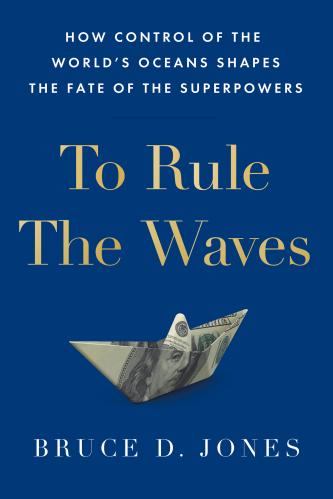
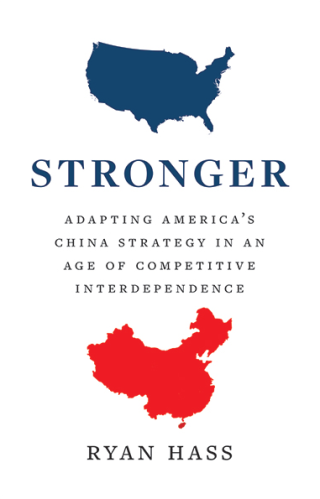
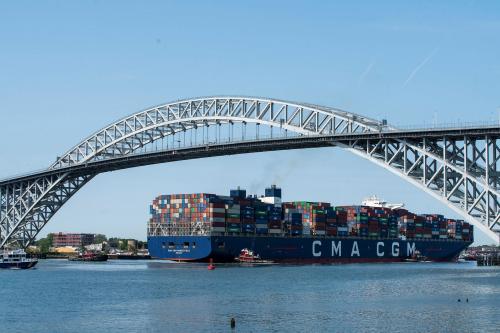
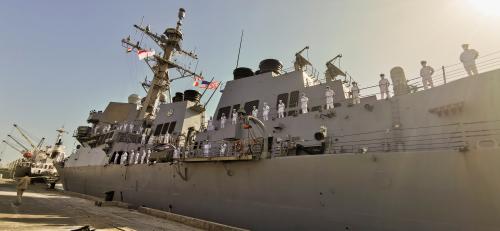
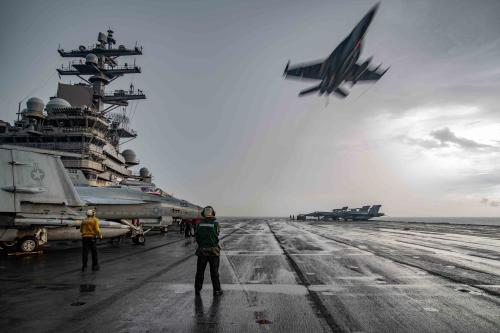



Commentary
To expand the Navy isn’t enough. We need a bigger commercial fleet.
November 4, 2021